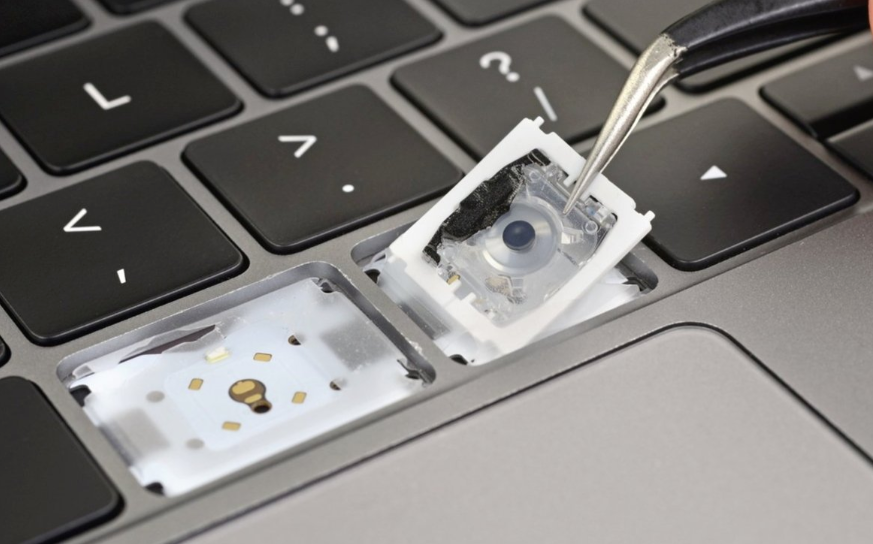Laptop / MacBook Keyboard Repair
Laptop Keyboard Repair – MacBook Keyboard Repair
When need this service:
What to do if your laptop keyboard isn’t working
If your keyboard has stopped working, you’re not completely out of luck. Whether you have a Windows laptop or an Apple MacBook, before you take the laptop to a repair shop or contact customer service, be sure to run through this checklist of troubleshooting tips to see if you can solve the problem on your own. Often, you can.
Restart the laptop
As a general rule, the first thing you should try when you encounter a computer problem that’s serious enough to keep you from getting work done is to restart the computer — turn it off and then back on again. Doing that flushes out the computer’s memory and restarts all your programs, drivers, and utilities, and that can be enough to restore your laptop to full operation.
So before you go any further, restart your Windows computer or restart your Mac.
Clean the keyboard
Sometimes, what at first seems like a serious hardware error is really a fairly mundane problem. If only some of your keys aren’t working properly, for example, there could be dirt and debris under the keys, keeping them from working properly.
To check if it’s simply a matter of dirt under the keys, start with a small brush or microfiber cloth and wipe the keys, trying to extract any debris that might have gotten caught under or between the keycaps. You should also dab a cloth with rubbing alcohol and gently but thoroughly wipe away any dried liquids or stuck-on dirt. For the most thorough cleaning, blast a can of compressed air into the gaps between keys.
See if it’s a hardware issue
Now that you’ve tried the easiest fixes, if the problem persists, you might want to determine if the problem is rooted in the keyboard’s hardware or if it’s a software issue in Windows. The easiest way to figure this out is to see if the keyboard works in a pre-boot environment. If the keyboard works fine before Windows starts, you can concentrate on software solutions. Otherwise, you should skip straight to getting the laptop serviced at Pro Computer.
1. Click Start and then Settings.
2. In the Settings search box, type “Recovery,” and then choose Recovery options in the search results.
3. In the Advanced startup section, choose Restart now.
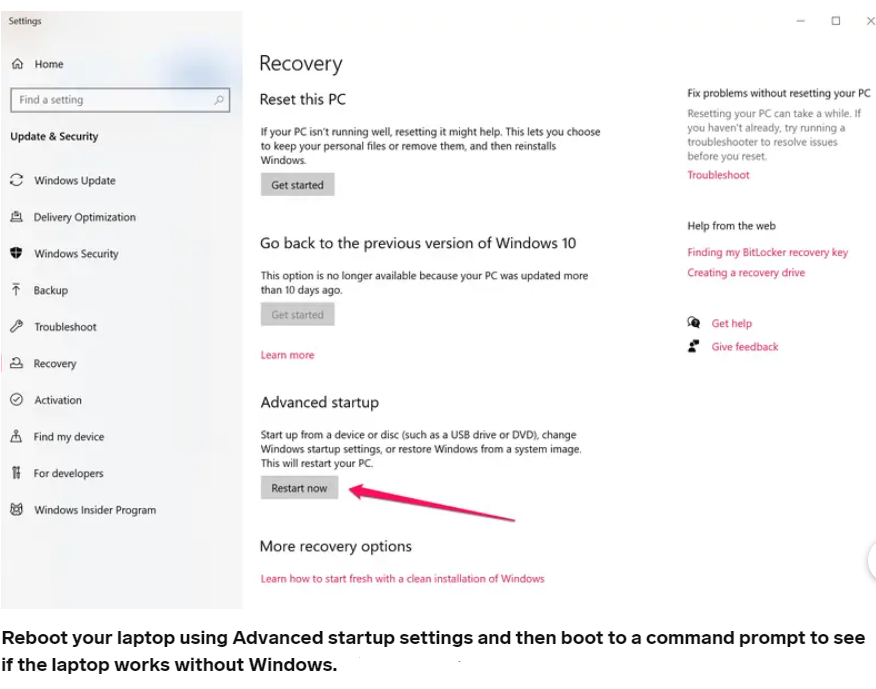
4. After the computer reboots, on the Choose an option screen, select Troubleshoot.
5. On the Troubleshoot screen, choose Advanced options.
6. Finally, on the Advanced options screen, choose Command Prompt.
7. When the command prompt opens, test your keyboard.
There’s no equivalent pre-boot environment for the Mac, so you should keep troubleshooting.
Check your keyboard drivers and settings
If it seems like your keyboard’s issues are caused by some sort of software issue, the next easiest troubleshooting step is to update your keyboard driver.
If you have a Windows laptop:
1. In the Start search box, type “Device manager” and click it when you see it appear in the search results.
2. Click the arrow to the left of Keyboard to expand the section.
3. Right-click your keyboard in the device list and choose Uninstall device.
4. Reboot your laptop, and Windows will automatically identify the laptop keyboard and install the latest driver for it.
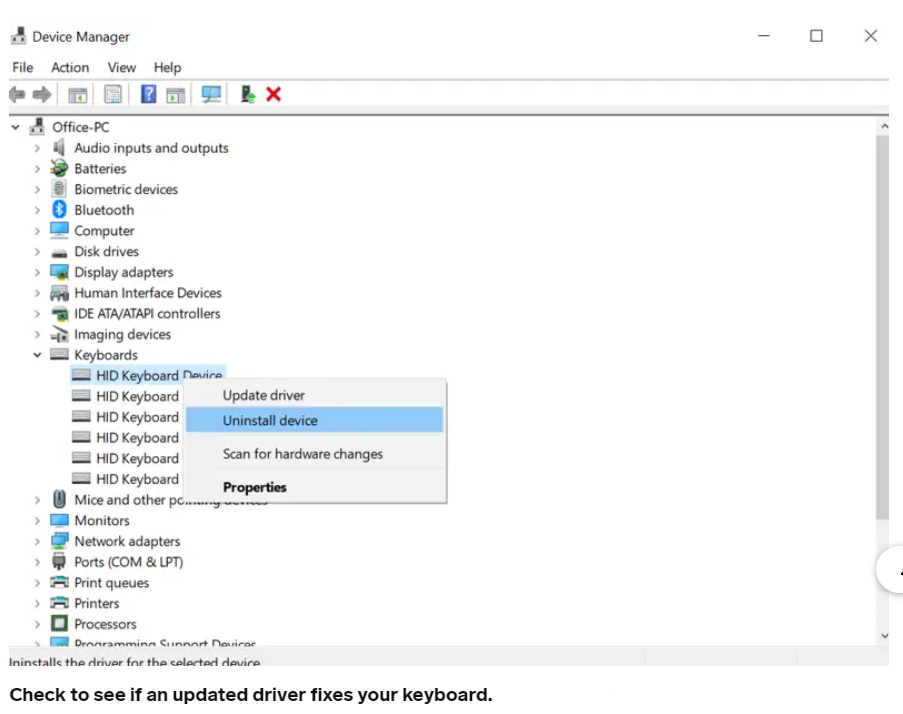
On a MacBook, do this:
1. Click the Apple logo at the top left of the screen and choose System Preferences.
2. Click Accessibility.
3. In the navigation pane on the left, scroll down and click Keyboard.
4. If Enable Slow Keys is selected, uncheck this option.
Make sure you have the right keyboard layout
If your keyboard sort of works but it seems to scramble what you’re trying to type with unusual characters or the wrong characters, the keyboard layout might have been changed by accident. Check the layout and fix it if needed:
If you have a Windows laptop:
1. Click Start and then click Settings.
2. In the Settings window, click Time & Language.
3. In the pane on the left, choose Language.
4. In the Preferred languages section, make sure the correct language is selected, such as English (United States). If not, click Add a language and add it.
5. Click the preferred language and then click Options.
6. Make sure the keyboard matches your type of keyboard, such as US – QWERTY.
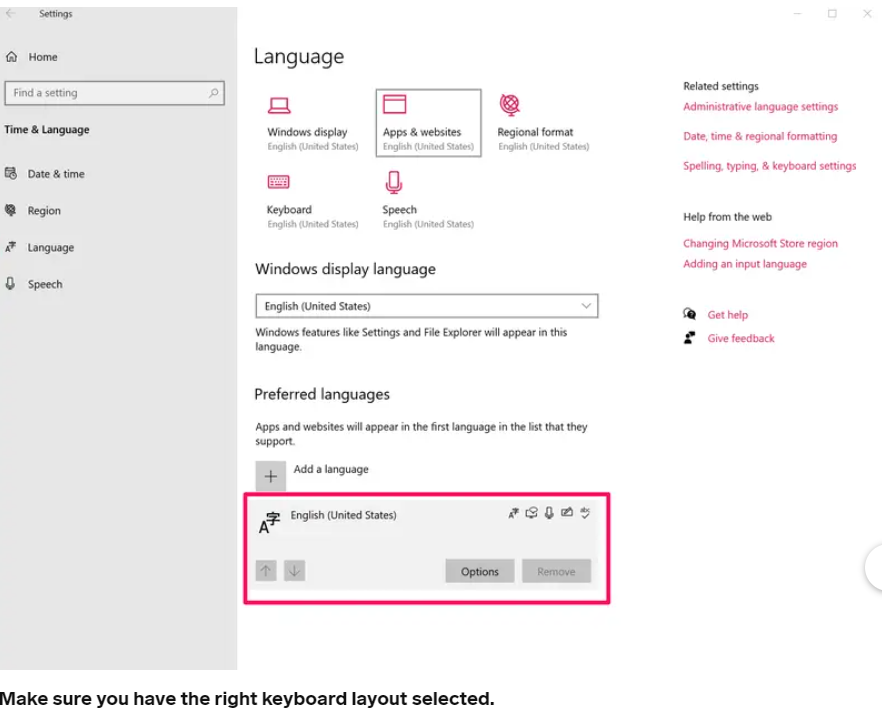
1. In the menu bar at the top of the screen, click System Preferences.
2. Click Keyboard.
3. In the tabs at the top, choose Input Sources.
4. Make sure that the correct keyboard type is shown in the pane on the left (such as U.S.). If not, click the checkbox for Show input menu in menu bar, then click the plus sign and choose a language.
Plug in an external keyboard
If your keyboard is still not working properly, plug an external USB keyboard into your laptop. In most cases, this keyboard will work fine regardless of whether your built-in keyboard is suffering from software or hardware issues. You can use this keyboard while you continue to troubleshoot the laptop or wait to get it serviced at Pro Computer.
Useful tech hints:
How to Fix It When a MacBook Pro Keyboard Isn’t Working
When a MacBook Pro keyboard stops working, you may find none of the keys work at all, or some keys work. If the Touch Bar doesn’t work, a software issue is likely the cause.
You’ll need to attempt fixes such as cleaning it, checking for updates, and removing potential problem apps to get your keyboard working again. Most of these fixes also work for MacBook Air keyboards.
What Causes a MacBook Pro Keyboard to Stop Working?
The most common causes for a MacBook keyboard to stop working are dust and other contaminants. If you have a MacBook with keys using Apple’s butterfly keyboard mechanism, even the smallest amount of dust contamination can cause problems. Other contaminants, such as food and various liquids, can also prevent a Mac keyboard from working correctly.
The most common reasons a MacBook keyboard stops working include:
- Dust and other contaminants
- Incorrect software settings
- Problematic apps
- Bugs and glitches
- Broken hardware
How to Fix a MacBook Pro Keyboard That Isn’t Working
If your keyboard stops working, the first step is to clean it. If that doesn’t work, you need to connect a spare keyboard and try a handful of other fixes. In a worst-case scenario, contact Apple for professional assistance. Don’t attempt any advanced repairs or disassembly yourself, as Apple fixes some of these problems at no charge.
Here’s how to fix a MacBook Pro keyboard that has stopped working:
1. Clean the keyboard. Dust and other debris represent the most common cause of malfunctioning MacBook keyboards, so start by cleaning your keyboard to the best of your ability. Here’s Apple’s recommended procedure:
- Hold the MacBook so that the base is at a 75-degree angle with the floor or table.
- Using compressed air with a straw to guide the pressurized air, blow between the keys in a left-to-right and top-to-bottom pattern.
- Rotate the MacBook so that the right side is facing down, and still, at about a 75-degree angle.
- Repeat the same left-to-right and top-to-bottom blowing pattern you used before.
- Rotate the MacBook again, so the left side is facing down, and still, at a 75-degree angle.
- Repeat the same blowing pattern you used before.
2. Plug in the MacBook. If your battery is low, the keyboard may not work, and you may not see a low battery alert. Wait for the MacBook to charge and then check to see if the keyboard works.
3. Check for updates. Connect a USB or wireless keyboard and perform the standard procedure of checking for updates. If your MacBook needs any driver or operating system updates, update them, and then see if the keyboard works.
4. Remove recent apps. If you installed one or more apps right before this problem started, it might be causing a conflict. Uninstall any apps you recently installed, restart your MacBook, and then check to see if the keyboard works.
5. Restart the Touch Bar. If the Touch Bar is the part of your MacBook Pro keyboard that isn’t working, you can usually use the terminal to get it working again. Here’s how that works:
- Type terminal into Spotlight, or open it via Finder > Applications > Utilities.
- With the Terminal open, type sudo pkill TouchBarServer; and press enter.
- Type sudo killall “ControlStrip”; and press enter.
- Enter your password and press enter.
- The Touch Bar shuts down and restarts.
6. Turn off Slow Keys. If this function is on, you have to hold down each key longer than usual before it registers. That can make it seem like the keyboard doesn’t work at all if you’re only pressing each key for a short amount of time. Here’s how to turn it off:
- Open the Apple menu.
- Navigate to System Preferences > Accessibility > Keyboard > Hardware.
- Make sure Slow Keys isn’t on.
7. Turn off Mouse Keys. This setting can cause problems if it’s accidentally turned on. To turn off Mouse Keys:
- Open the Apple menu.
- Navigate to System Preferences > Accessibility > Pointer Control > Alternate Control Methods.
- Make sure Mouse Keys isn’t on.
8. Check the keyboard layout setting. If you have the wrong keyboard layout set, the keys won’t function as expected. Here’s how to check:
- Open the Apple menu.
- Navigate to System Preferences > Keyboard > Input Sources.
- Select Show Input menu in menu bar.
- Open the Input menu and select the correct keyboard layout for your region and language.
9. Reset the System Management Controller (SMC). If there’s a problem with your MacBook’s SMC, it may result in the keyboard not working correctly. Resetting the SMC usually takes care of the problem.
What If Your MacBook Keyboard Still Doesn’t Work?
If your keyboard still doesn’t work after you attempt all these fixes, or it’s just specific keys that don’t work, you need to seek professional help from Pro Computer.
FAQs
1) My cat scratched some keys off the keyboard, can you put it back?
A: Yes. Bring in all the key caps and springs you could gather, I will try to get the best result.
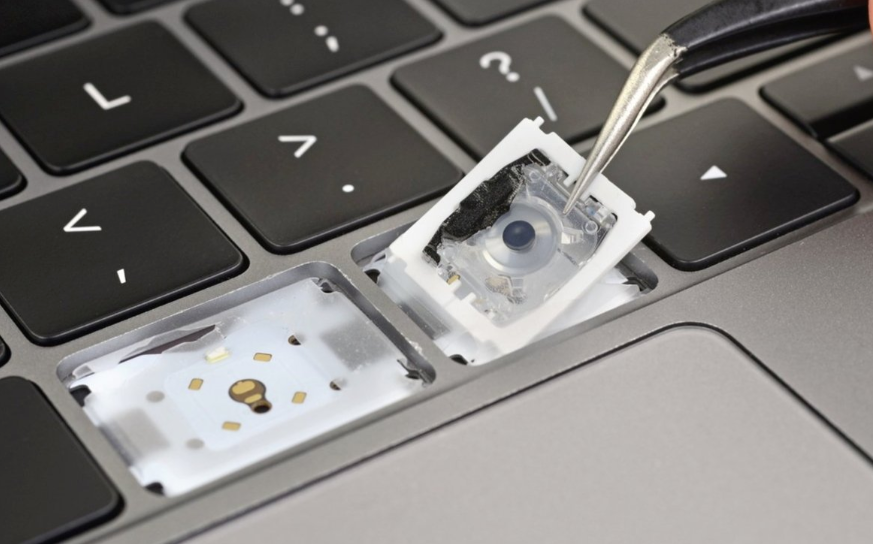
2) I spilled a little bit water over my MacBook air keyboard, and some keys stopped working days after. Can you fix it?
A: Seems the liquid find its way to the PCB layer and caused erosion damage. The whole keyboard/ palm rest need to be replaced. There are refurbished parts available for less cost. Contact Pro Computer for details.
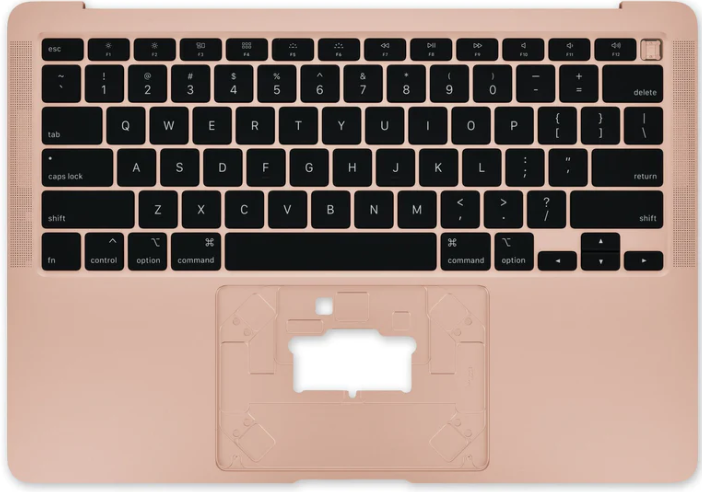
Thank you so much for being so patient, professional and wonderful. I will recommend your store and services to others!
Request a Free Quote
"*" indicates required fields

